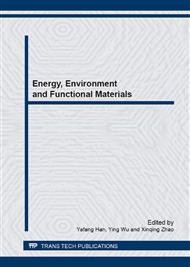[1]
Hu B., Wang K., Wu L., Yu S., Antonietti M., Titirici M.M., Engineering Carbon Materials from the Hydrothermal Carbonization Process of Biomass. Adv. Mater., 22(2009) 813–828.
DOI: 10.1002/adma.200902812
Google Scholar
[2]
Titirici M.M., Antonietti M., Chemistry and materials options of sustainable carbon materials made by hydrothermal carbonization. Chem. Soc. Rev. 39(2010) 103-116.
DOI: 10.1039/b819318p
Google Scholar
[3]
Zerbino, R., Giaccio, G., Isaia, G. C., Concrete incorporating rice-husk ash without processing. Constr Build Mater, 25 (2011) 371-378.
DOI: 10.1016/j.conbuildmat.2010.06.016
Google Scholar
[4]
Horsakulthai, V.; Phiuvanna, S.; Kaenbud, W., Investigation on the corrosion resistance of bagasse-rice husk-wood ash blended cement concrete by impressed voltage . Constr Build Mater, 25 (2011) 54-60.
DOI: 10.1016/j.conbuildmat.2010.06.057
Google Scholar
[5]
Lu Q., Yang X., Zhu X., Analysis on chemical and physical properties of bio-oil pyrolyzed from rice husk. Journal of Analytical and Applied Pyrolysis, 82(2008) 191–198
DOI: 10.1016/j.jaap.2008.03.003
Google Scholar
[6]
Ting Li, TaoWang. Preparation of silica aerogel from rice hull ash by drying at atmospheric pressure.Materials Chemistry and Physics, 112(2008) 398-401
DOI: 10.1016/j.matchemphys.2008.05.066
Google Scholar
[7]
Xiaoyu Ma, Bing Zhou, Wei Gao, Yuning Qu, Lili Wang, Zichen Wang, Yanchao Zhu, A recyclable method for production of pure silica from rice hull ash, Powder Technology 217(2012) 497–501.
DOI: 10.1016/j.powtec.2011.11.009
Google Scholar
[8]
Zhang, H., Zhao, X., Ding, X., Lei, H., Chen, X., An, D., Li, Y., Wang, Z.. A study on the consecutive preparation of D-xylose and pure superfine silica from rice husk. Bioresour. Technol. 101(2010) 1263–1267.
DOI: 10.1016/j.biortech.2009.09.045
Google Scholar
[9]
Lili Wang, Yupeng Guo, Yanchao Zhu, Ying Li, Yuning Qu, Chunguang Rong, Xiaoyu Ma, Zichen Wang. A new route for preparation of hydrochars from rice husk, Bioresource Technology, 101 (2010): 9807–9810.
DOI: 10.1016/j.biortech.2010.07.031
Google Scholar
[10]
Paul C, Chieng, etal, Method of production of high purity fusible silica, U.S. Patent: 5028407 (1991).
Google Scholar
[11]
D.H. Nagaraja, R.A. Venkateswara, Organic modification of TEOS based silica aerogels using hexadecylltrimethoxysilane as a hydrophobic reagent, Applied Surface Science. 253 (2006) 1566–1572.
DOI: 10.1016/j.apsusc.2006.02.036
Google Scholar
[12]
D.A. Maria, Z.H. Luan, J. Klinowski, J. Phys. Chem. 100 (1996) 2178.
Google Scholar
[13]
R.F.S. Lenza, W.L. Vasconcelos, Mater. Res. 4 (2001) 189.
Google Scholar
[14]
Q.W. Chen, X.G. Li, Y.H. Zhang and Y.T. Qian, Ferroelectric properties of porous silicon. Adv. Mater. 25 (2002) 134-137.
Google Scholar
[15]
Wang, Q., Li, H., Chen, L., Huang, X., Monodispersed hard carbon spherules with uniform nanopores. Carbon, 39(2001) 2211–2214.
DOI: 10.1016/s0008-6223(01)00040-9
Google Scholar
[16]
Wang, Z., Stein, A., Morphology Control of Carbon, Silica, and Carbon/Silica Nanocomposites: From 3D Ordered Macro-/Mesoporous Monoliths to Shaped Mesoporous Particles. Chem. Mater. 20 (2008) 1029–1040.
DOI: 10.1021/cm0717864
Google Scholar


